‘How to Transcend a Happy Marriage’ fascinating study of dissociative disorder
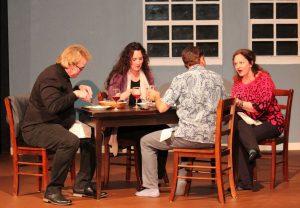 Sarah Ruhl’s How to Transcend a Happy Marriage is a titillating little tome, but not because it features a tightly-choreographed fully-clothed orgy to end Act One. But rather because it’s a fascinating study of dissociative disorder the likes of which we haven’t seen since “Goodbye, Farewell and Amen” aired 37 years ago on February 28, 1983.
Sarah Ruhl’s How to Transcend a Happy Marriage is a titillating little tome, but not because it features a tightly-choreographed fully-clothed orgy to end Act One. But rather because it’s a fascinating study of dissociative disorder the likes of which we haven’t seen since “Goodbye, Farewell and Amen” aired 37 years ago on February 28, 1983.
Whether 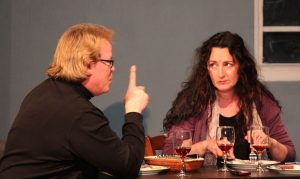 or not you were a M*A*S*H devotee, you probably saw a rerun of the series finale a time or two. And whether you saw it in real time or syndication, the memory of Hawkeye’s mental breakdown lingers to this very day. In brief, a bus in which Hawkeye is riding has pulled off the main road to avoid detection by a marauding Chinese patrol.
or not you were a M*A*S*H devotee, you probably saw a rerun of the series finale a time or two. And whether you saw it in real time or syndication, the memory of Hawkeye’s mental breakdown lingers to this very day. In brief, a bus in which Hawkeye is riding has pulled off the main road to avoid detection by a marauding Chinese patrol. 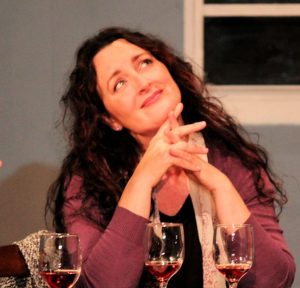 But there’s a woman traveling with a chicken and its incessant clucking threatens to give away their position. Finally, Hawkeye yells at her to keep the chicken quiet and seeing no other alternative, she smothers the poor animal to protect everyone on the bus. Hawkeye is so guilt-ridden that he breaks down and ends up in a mental hospital, where he’s seen by psychiatrist Sidney Freedman. With Sidney’s help, Hawkeye finally accepts that the chicken was actually a baby and the role he played in causing the mother to take her child’s life.
But there’s a woman traveling with a chicken and its incessant clucking threatens to give away their position. Finally, Hawkeye yells at her to keep the chicken quiet and seeing no other alternative, she smothers the poor animal to protect everyone on the bus. Hawkeye is so guilt-ridden that he breaks down and ends up in a mental hospital, where he’s seen by psychiatrist Sidney Freedman. With Sidney’s help, Hawkeye finally accepts that the chicken was actually a baby and the role he played in causing the mother to take her child’s life.
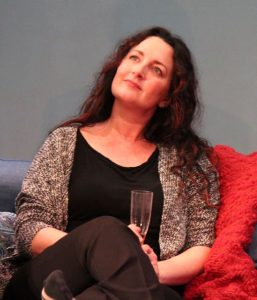 Dissociative disorders usually develop in response to trauma. They’re coping mechanism that function to keep difficult memories at bay. Symptoms range from amnesia and distorted or unreal perceptions of the people and objects to alternate identities and even dissociative identity disorder (known as multiple personalities in a less enlightened age). While How to Transcend a Happy Marriage is not The Three Faces of Eve or Sybil, its central character, George, displays both dissociative amnesia and distorted perceptions in the aftermath of the aforementioned orgy scene that ends Act One.
Dissociative disorders usually develop in response to trauma. They’re coping mechanism that function to keep difficult memories at bay. Symptoms range from amnesia and distorted or unreal perceptions of the people and objects to alternate identities and even dissociative identity disorder (known as multiple personalities in a less enlightened age). While How to Transcend a Happy Marriage is not The Three Faces of Eve or Sybil, its central character, George, displays both dissociative amnesia and distorted perceptions in the aftermath of the aforementioned orgy scene that ends Act One.
What triggers 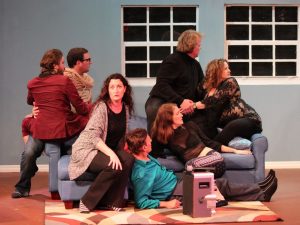 George’s adaptive/maladaptive dissociative disorder is her inability to reconcile her desire for and role in the orgy with her strongly-entrenched internalization of societal norms about marriage, monogamy, heterosexuality and the boundaries of friendship. On a deeper and more profound level, it also implicates the fracture experienced by modern-day men and women between their “higher” rational selves
George’s adaptive/maladaptive dissociative disorder is her inability to reconcile her desire for and role in the orgy with her strongly-entrenched internalization of societal norms about marriage, monogamy, heterosexuality and the boundaries of friendship. On a deeper and more profound level, it also implicates the fracture experienced by modern-day men and women between their “higher” rational selves 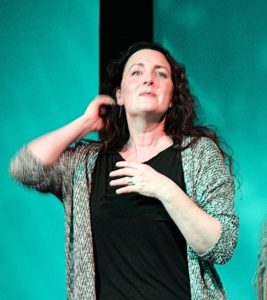 and “base” animal nature. In fact, George’s best friend, Jane, poignantly encapsulates this ironic dichotomy when she shouts, “You have to become an animal in order to have children and then you have a child and have to disguise your animal nature ever after!”
and “base” animal nature. In fact, George’s best friend, Jane, poignantly encapsulates this ironic dichotomy when she shouts, “You have to become an animal in order to have children and then you have a child and have to disguise your animal nature ever after!”
To see how these tensions play out on stage, you’ll need to drive down to the Laboratory Theater of Florida, purchase a ticket and watch the performance. But even if you’re not into the psychological underpinnings that motivate the characters in this play or any other or the larger themes that playwright Sarah Ruhl expresses through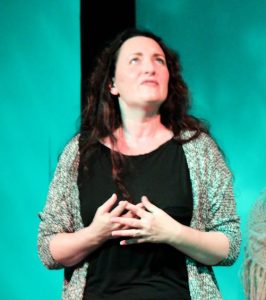 How to Transcend a Happy Marriage, you will be treated to sound direction by Steven Ditmyer and riveting performances from Annette Trossbach as George, Paul Graffy as her husband, Paul, Scott Davis and Heather Johnson as their best friends, Michael and Jane, and Tamicka Armstrong, Steven Coe and TJ Albertson as polyamorous Pip and her triad.
How to Transcend a Happy Marriage, you will be treated to sound direction by Steven Ditmyer and riveting performances from Annette Trossbach as George, Paul Graffy as her husband, Paul, Scott Davis and Heather Johnson as their best friends, Michael and Jane, and Tamicka Armstrong, Steven Coe and TJ Albertson as polyamorous Pip and her triad.
Because she’s adamant that The Lab not serve as vanity theater and she’s otherwise consumed with finding choice plays to produce and fixing up “this old theater,” it’s rare to see Trossbach on stage. So it’s easy to forget just how good she can be when she does 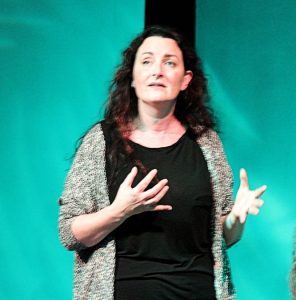 step into the footlights. And with all due credit to Marisa Tomei, her evocation of this character is as good as it gets.
step into the footlights. And with all due credit to Marisa Tomei, her evocation of this character is as good as it gets.
Trossbach reveals in tantalizing dribs, drabs and throwaway lines plenty of insight into the conditions that predispose her to a bout of dissociative disorder. A high school Latin teacher (nullum magnum ingenium sine mixture dementia fuit), George lives mostly in her head. It’s a crowded, self-righteous, judgmental and rarified space, and not even her husband is safe from her air of superiority. 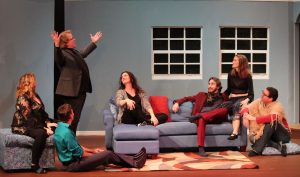 As many disgruntled spouses are wont to do, she makes snide and snarky comments to her friends about her husband’s lack of ambition and her correlative need to return to teaching. And rather than being appalled by her husband’s unconcealed interest in polyamory, she betrays her own prurient interest in experimenting with multiple partners,
As many disgruntled spouses are wont to do, she makes snide and snarky comments to her friends about her husband’s lack of ambition and her correlative need to return to teaching. And rather than being appalled by her husband’s unconcealed interest in polyamory, she betrays her own prurient interest in experimenting with multiple partners, 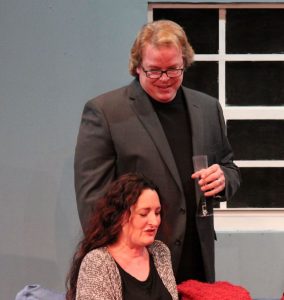 perhaps even same sex partners as well.
perhaps even same sex partners as well.
This may be Heather Johnson’s best role to date. Next to George, playwright Sarah Ruhl infuses George’s best friend, Jane, with a delightful constellation of nuance, depth and angst. Johnson plays the part with studied understatement and she excels in her scenes with her on-stage daughter, Jenna (Madalyn Brown), who walks in on her mom’s New Year’s Eve party at the height of their frenzied orgy.
And Brown, in turn, makes the most of her time on stage too.
Graffy, Davis, Armstrong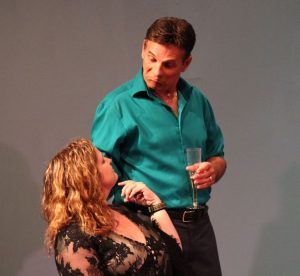 , Coe and Albertson are superb too, but they are saddled with characters who are constructs of George’s tenuous hold on reality. As a result they are more two-dimensional cardboard cut-outs than complex, 3D people. Graffy and Davis play the husbands, who display all the warmth toward their polyamorous guests of randy cultural anthropologists. While Graffy’s Paul evinces a physical and emotional connection with his wife, Davis’ Michael conveys an eyebrow-raising lack of connection with Jane –
, Coe and Albertson are superb too, but they are saddled with characters who are constructs of George’s tenuous hold on reality. As a result they are more two-dimensional cardboard cut-outs than complex, 3D people. Graffy and Davis play the husbands, who display all the warmth toward their polyamorous guests of randy cultural anthropologists. While Graffy’s Paul evinces a physical and emotional connection with his wife, Davis’ Michael conveys an eyebrow-raising lack of connection with Jane –
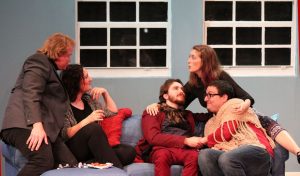 which may actually exist or simply be a manifestation of George’s perception.
which may actually exist or simply be a manifestation of George’s perception.
And what we are given of Pip, Daveed (it’s actually David, but, well, you get the gist) and Freddie is even more slanted. Pip (Tamicka Armstrong), for example, 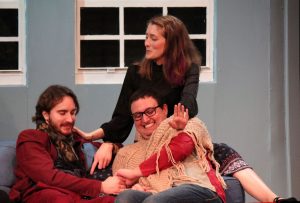 is a free spirit in the tradition of Jill (Goldie Hawn) from Butterflies Are Free or Jenny Curran (more Hanna Hall than Robin Wright) in Forrest Gump. David (Steven Coe) is a pretentious European mathematician who spouts off about Pythagoras to impress strangers (the play is about triangles, after all). And Freddie (heroically played by poor TJ Albertson) does as little as
is a free spirit in the tradition of Jill (Goldie Hawn) from Butterflies Are Free or Jenny Curran (more Hanna Hall than Robin Wright) in Forrest Gump. David (Steven Coe) is a pretentious European mathematician who spouts off about Pythagoras to impress strangers (the play is about triangles, after all). And Freddie (heroically played by poor TJ Albertson) does as little as 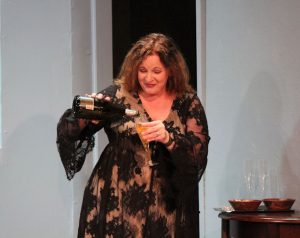 he can get away with, and says even less.
he can get away with, and says even less.
This isn’t a criticism. It’s intentional on Ruhl’s part. While most plays present the characters who appear on stage from an objective POV, the story unfolding on stage in How to Transcend a Happy Marriage is a reflection of George’s mental and emotional state. As such, it doesn’t purport to be accurate. Rather, it’s a product of her views, values and defense mechanisms – which George imparts 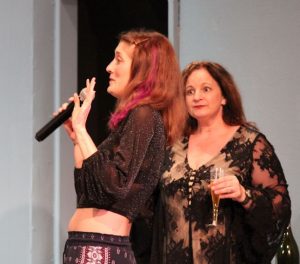 periodically as she steps into the role of narrator and talks directly to the audience. So what we see and hear comes to us through the filter of George’s perception, and she unapologetically sees men as superficial, banal cartoon caricatures, Pip as wild and unrestrained as a bird, and Jane as sensual, complex and worthy of her love and admiration.
periodically as she steps into the role of narrator and talks directly to the audience. So what we see and hear comes to us through the filter of George’s perception, and she unapologetically sees men as superficial, banal cartoon caricatures, Pip as wild and unrestrained as a bird, and Jane as sensual, complex and worthy of her love and admiration.
As stated, How to Transcend a Happy Marriage is an interesting little tome – part psychoanalytical study and part morality play. But perhaps it would be best to let George unravel 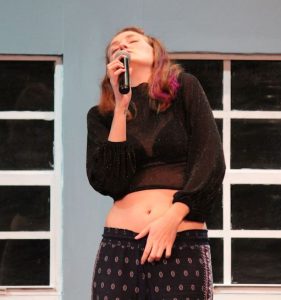 the meaning of the story in her own words. Ah, but what words would those be? Factum fieri infectum non potest or “It is impossible for a deed to be undone?” or Carpe vinum – “Seize the wine”? Or in this case, seize the vegan hash brownies and the psychedelic mushroom tea.
the meaning of the story in her own words. Ah, but what words would those be? Factum fieri infectum non potest or “It is impossible for a deed to be undone?” or Carpe vinum – “Seize the wine”? Or in this case, seize the vegan hash brownies and the psychedelic mushroom tea.
How to Transcend a Happy Marriage runs through March 14.
February 25, 2020.
RELATED POSTS













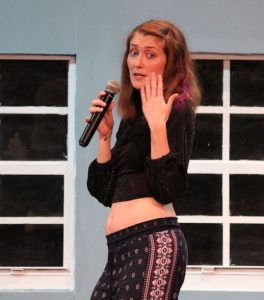

 Tom Hall is both an amateur artist and aspiring novelist who writes art quest thrillers. He is in the final stages of completing his debut novel titled "Art Detective," a story that fictionalizes the discovery of the fabled billion-dollar Impressionist collection of Parisian art dealer Josse Bernheim-Jeune, thought by many to have perished during World War II when the collection's hiding place, Castle de Rastignac in southern France, was destroyed by the Wehrmacht in reprisal for attacks made by members of the Resistance operating in the area. A former tax attorney, Tom holds a bachelor's degree as well as both a juris doctorate and masters of laws in taxation from the University of Florida. Tom lives in Estero, Florida with his fiancee, Connie, and their four cats.
Tom Hall is both an amateur artist and aspiring novelist who writes art quest thrillers. He is in the final stages of completing his debut novel titled "Art Detective," a story that fictionalizes the discovery of the fabled billion-dollar Impressionist collection of Parisian art dealer Josse Bernheim-Jeune, thought by many to have perished during World War II when the collection's hiding place, Castle de Rastignac in southern France, was destroyed by the Wehrmacht in reprisal for attacks made by members of the Resistance operating in the area. A former tax attorney, Tom holds a bachelor's degree as well as both a juris doctorate and masters of laws in taxation from the University of Florida. Tom lives in Estero, Florida with his fiancee, Connie, and their four cats.